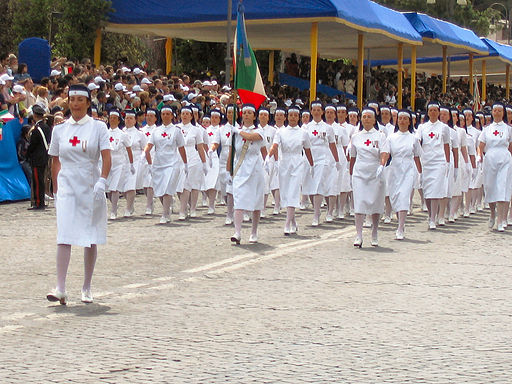 |
| (By Utente:Jollyroger (Own work) [CC BY-SA 2.5 (http://creativecommons.org/licenses/by-sa/2.5)], via Wikimedia Commons) |
Nursing and theory development
“Nursing is a profession with unique body of knowledge and well principled skills, emphasis on care of human being during ill health to health continuum by meeting the needs physically, psychologically, socially and medically with modification of environment of individual, family and community through nursing practice, education and research”.
Theoretical thinking
The first unit of theory is concept. A concept is an idea or thought comes to mind through experience or observation. The concepts are divided into two; empirical and abstract. The empirical concepts (phenomena) are observed through senses, for example, heart rate and abstract concepts (intuition) are not observable, for example, caring.
The term metaparadigm indicates the boundaries of a discipline which summarizes the mission of the same discipline. There are four metaparadigm related to nursing; person, health, environment and nursing. The person represents individual, family or community. Health is a state of well being and environment is the surroundings of the person and nursing is the practice of the science based on the aspect of ‘care’, ‘cure’ and ‘prevention’. A proposition explains the relationships between the concepts.
“A theory is a creative arrangement of concepts with definitions and its propositions in general, which describes the phenomena or intuition and its relationships, predict the actions and reactions through the research and solve problems in the reality”.
“A conceptual framework is a pictorial representation of theory or conceptual model”.
“A conceptual model is a creative arrangement of concepts related to specific event or problem in the reality with definitions and its propositions, which describes the phenomena or intuition and its relationships, predict the actions and its reactions through the research and solve the problems in the reality”.
Barnum (1998) stated that a complete nursing theory is one that contains context, content and process. Context is an environment, content is the subject and process is the way of act to use the theory.
Smith and Liehr (2003) suggested three rungs for the model; philosophical, theoretical and empirical. The philosophical (highest) rung represents the beliefs and assumptions which are true and fundamental to a theory. The theoretical (middle) rung is abstract and consists of the symbols, ideas and concepts of the theory and empirical (lowest) rung is concrete, which is observed by senses.
Levels of theory
Chinn and Kramer (2004) stated that theory is divided into micro, macro, midrange, atomistic or wholistic. Micro and atomistic suggests narrow range, where as, macro and wholistic implies a broad range. Middle range theories deal with a portion of nursing’s total concern but not with the totality of the discipline. Grand theory covers broad areas of concern with a discipline and meta theory is about theoretical process and theory development. Middle range theories are based on day to day research, narrow in scope, limited number of concepts and propositions, less abstract and more applicable to practice.
Im (1999) stated that situation specific theories are focused on specific nursing intervention phenomena, limited to specific population, are not intended to be universal theories and are may or may not be testable.
Dickoff and James (1968) developed theory on four levels:
Level 1: factor isolating – is descriptive in nature and naming or classifying the events.
Level 2: factor relating – associating or correlating factors
Level 3: situation relating – explains and predicts how situations are related
Level 4: situation producing – it requires sufficient knowledge about how and why situations are related. Level 4 being the most powerful, as it controls rather than description, explanation or prediction.
Fawcett (2005) described various types of middle range theory. She stated that middle range theories describe what a phenomenon is, explain why it occurs and predict how it occurs. Middle range descriptive theories describe only one concept or classify a phenomenon. Middle range explanatory theories specify relations between two or more concepts and middle range predictive theories predict relationship between concepts.
Johnson and Webber (2005) propose a criterion based critique model for nursing theories.
Phase 1: Intention of the theory
- Criterion I: understandable meaning
- Criterion II: consistent boundaries
- Criterion III: understandable language
- Criterion IV: identify the major concepts
- Criterion V: formulation of propositions
- Criterion VI: understand and interpret the propositions
- Criterion VII: explains and predicts the phenomena
- Criterion VIII: influences nursing practice
No comments:
Post a Comment